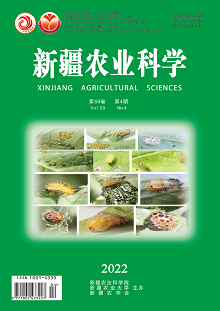【Objective】 To study the effects of irrigation amount and planting density on photosynthetic characteristics and yield of drip irrigation membrane-free cotton.【Method】 Field tests designed by the two-factor split zone were carried out with "medium 619" as the test material, the main area was irrigation amount, which was 3,000 m3/hm2 (W1), 4,500 m3/hm2 (W2) and 6,000 m3/hm2 (W3), respectively; the sub-area was density, which was 29.24×104/hm2(M1), 26.32×104/hm2 (M2), 23.92×104/hm2 (M3) and 21.93×104/hm2 (M4), respectively, to study the dynamics of membrane-free cotton population leaf area index (LAI), photolysis indicators and yield differences.【Results】 Full-blooming stage was the maximum period of filmless cotton LAI and photolysis function, and the LAI increased with density and irrigation amount.The LAI change of W2M3treatment was more stable and higher in the later stage.The LAI of W3M1 treatment was the highest, but it decreased rapidly after the full flowering stage.Suitable irrigation and reasonable density were beneficial to the improvement of photosynthetic function of leaves.The treatments W2M3, W2M4 and W3M3 had higher Pn, Gs and Tr and lower Ci at full flowering stage, and the diurnal photosynthetic "midday depression" was not obvious, and its maximum values were 29.10-32.15 μmolCO2/(m 2·s), 0.91-1.07 mol/(m2·s), 12.78-13.87 mmolH2O /(m2·s) and 112.1-131.0 μmolCO2/mol, respectively, and the yield reached a high level of 6,890.71-7,496.79 kg/hm2.Although the LAI and photosynthetic index of W3M4 treatment were higher, they decreased too fast in the later stage, while the W1M1 showed the lowest, indicating that too high or too low irrigation and density were not conducive to the improvement of photosynthetic function of leaves.The effects of irrigation amount and density on leaf growth and photosynthetic index had interaction effect, and the effect of density was higher than that of water.【Conclusion】 Through analysis, the suitable irrigation amount and planting density in this region are 4,500-6,000 m3/hm2 and 21.93×104-23.62×104/hm2.The highest yield is 7,508.82 kg/hm2 when the irrigation amount is 5,034.73 m3/hm2 and the planting density is 24.63 × 10 4 /hm2.

